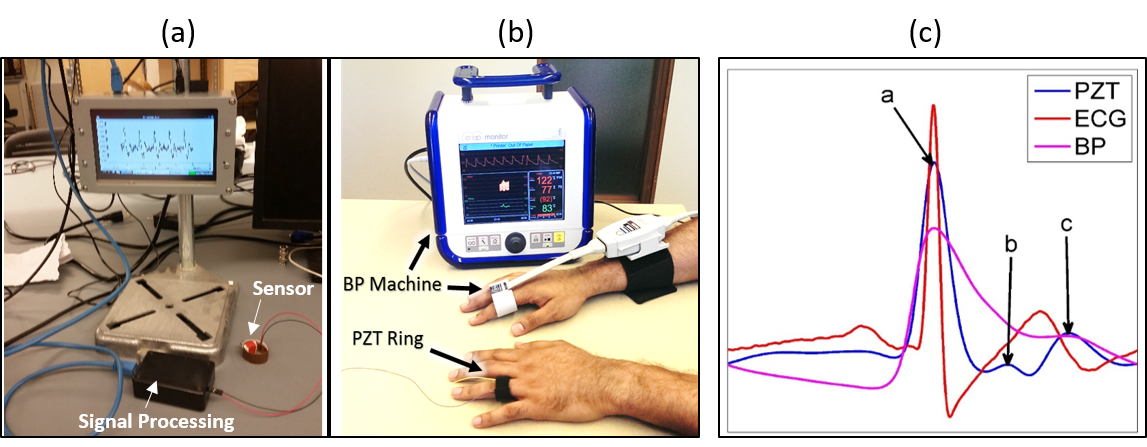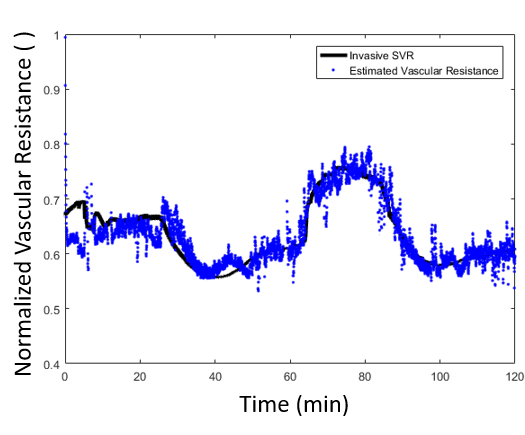Small-scale transduction mechanisms and materials provide opportunities to perform physiological monitoring in a minimally invasive and/or minimally disruptive manner. The primary focus of current work in the Vibration and Acoustics: Microsystems Laboratory is on cardiovascular monitoring using compliant piezoelectric pressure sensing, coupled with local dynamic models for peripheral arteries and complementary sensing mechanisms. Our goal is to provide simple, point-of-care monitoring of peripheral vascular resistance, having importance to disorders such as shock, intradialytic hypotension, and trauma.

Images: Our compliant piezoelectric sensing ring (a) provides a unique profile from peripheral arterial pressure waveforms, which in combination with (b) conventional blood pressure (BP) and/or photoplethysmograph (PPG) or (c) electrocardiogram signals can permit estimation of changes in vascular resistance, as in vascular resistance monitoring of swinem below.

Collaborators:
Kevin E. Ward, MD, Department of Emergency Medicine, University of Michigan
Prof. Kayvan Najarian, Department of Computer Science and Department of Emergency Medicine, University of Michigan
Michael Heung, MD, Department of Nephrology, University of Michigan
Dr. Sardar Ansari, Department of Emergency Medicine, University of Michigan
Other Projects:
- Continuous blood flow monitoring for severe TBI: Miniature piezoelectric and optical sensing embedded in a conventional intracranial pressure sensor for measurement of flow and cerebrovascular resistance changes within existing clinical workflows.
- Instrumented surgical instruments: The miniaturization of various sensors and actuators is being studied for installation at the working surface of surgical tools, to allow unprecedented control and awareness of device performance.
- Eye motion monitoring: Physical, mechanical monitoring of eye movement during sleep may provide a direct measure of duration of phases of sleep, with minimal compounding from other physiological changes.
Related Publications:
- L. Wang, S. Ansari, K. Najarian, K.R. Ward, and K.R. Oldham, “Decompensation prediction in hemodialysis by a feedback model as identified by miniature wearable sensors,” Proceedings of 2019 IEEE/ASME International Conference on Advanced Intelligent Mechatronics, Hong Kong, July 2019 (pdf).
- L. Wang, S. Ansari, D. Slavin, K. Ward, K. Najarian, and K.R. Oldham, “Non-invasive vascular resistance monitoring with a piezoelectric sensor and photo plethysmogram,” Sensors and Actuators A: Physical, vol. 263, pp. 198-208, 2017. (pdf)
- S. Ansari, S. Molaei, K. Oldham, M. Heung, K.E. Ward, and K. Najarian, “An extended Kalman filter approach with state inequality constraints for real-time detection of intradialytic hypotension using a PVDF sensor,” 39th Annual International Conference of the IEEE Engineering in Medicine & Biology Society, JeJu Island, S. Korea, July 2017. (pdf)
- L. Wang, S. Ansari, K. Najarina, K.R. Ward, and K.R. Oldham, “Estimation of peripheral artery radius using non-invasive sensor and Kalman filtering of local dynamics,” Proceedings of the American Controls Conference, Seattle, WA, July 2017.
- S. Ansari, N. Farzeneh, M. Heung, K.R. Oldham, H. Derksen, K.R. Ward, K. Najarian, “Real-time detection of intradialytic hypotension using a novel polyvinylidene fluoride based sensor,” IEEE-EMBS International Conference on Biomedical and Health Informatics, Las Vegas, NV, February 2016. (pdf)
- J. Choi, R. Lin*, H. Cho*, C.-H. Rhee, and K.R. Oldham, “Instrumentation of steel syringe needles with shadow-masked thin-films,” Proceedings of the ASME International Design Engineering Technical Conferences, Buffalo, NY, August 2014.
